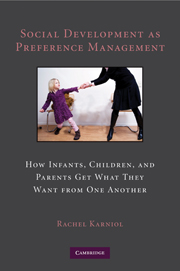 Social Development as Preference Management
Social Development as Preference Management Book contents
- Frontmatter
- Contents
- Acknowledgments
- Introduction
- 1 The Baby “Preference Game”
- 2 Children's Expression of Preferences
- 3 Emerging Meta-Preferences
- 4 Other People's Preferences
- 5 Parenting and Preference Management
- 6 Channeling Children's Preferences
- 7 Temporizing Preferences
- 8 Restricting Children's Preferences
- 9 Disciplining Noncompliance
- 10 Planes of Transformational Thought: Temporal, Imaginal, and Mental
- 11 Manipulating Others
- 12 Coping and Self-Regulating
- 13 Mind Play: Applying Transformational Thought
- 14 Minding One's Own Versus Others' Preferences: Altruism, Aggression, and Morality
- 15 Tying Up
- References
- Subject Index
- Name Index
13 - Mind Play: Applying Transformational Thought
Published online by Cambridge University Press: 05 June 2012
- Frontmatter
- Contents
- Acknowledgments
- Introduction
- 1 The Baby “Preference Game”
- 2 Children's Expression of Preferences
- 3 Emerging Meta-Preferences
- 4 Other People's Preferences
- 5 Parenting and Preference Management
- 6 Channeling Children's Preferences
- 7 Temporizing Preferences
- 8 Restricting Children's Preferences
- 9 Disciplining Noncompliance
- 10 Planes of Transformational Thought: Temporal, Imaginal, and Mental
- 11 Manipulating Others
- 12 Coping and Self-Regulating
- 13 Mind Play: Applying Transformational Thought
- 14 Minding One's Own Versus Others' Preferences: Altruism, Aggression, and Morality
- 15 Tying Up
- References
- Subject Index
- Name Index
Summary
A first grader explains what happens when he hurts his sister: ‘So like, if they say, ‘Now go to your room and think about what you've done,’ I just go to my room and I think about something else. I use my will power not to think about what they want me to think about. Then I just look real sad when I come out and they think I was in there thinking about my dumb sister.’
(Carlisle, 1994, p. 212)Rubin's son, Elihu, 2½ years old, is crying. An older preschooler tries to appease him. ‘Want some pizza?’ He replies, ‘No, I don't want pizza.’ She offers: ‘Want to ride my bicycle?’ but he rejects the offer: “No, I don't want to ride on a bicycle.” She tries again: “Want to see a dragon?” he stops crying and eagerly says ‘Yes.’
(Rubin, 1980, p. 120)In Chapter 10, I discussed transformational thought as occurring on three planes: (1) the temporal plane, allowing us to transform the present into the past and the realistic future; (2) the imaginal plane, transporting us into the imaginal future and into fictional worlds; and (3) the plane of the mental, imbuing others with covert psychological processes. As indicated in Chapter 10, being able to transform the here-and-now on the temporal, the imaginal, and the mental planes allows for the possibility of deploying transformations strategically, changing how we and others think and feel.
- Type
- Chapter
- Information
- Social Development as Preference ManagementHow Infants, Children, and Parents Get What They Want from One Another, pp. 269 - 291Publisher: Cambridge University PressPrint publication year: 2010


